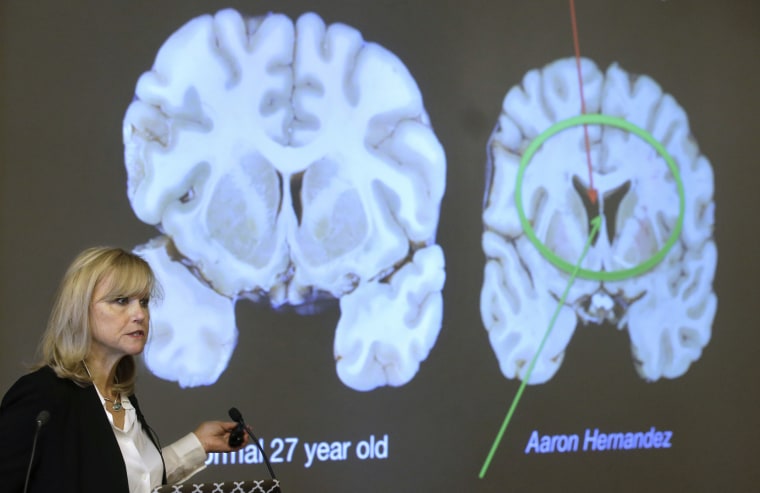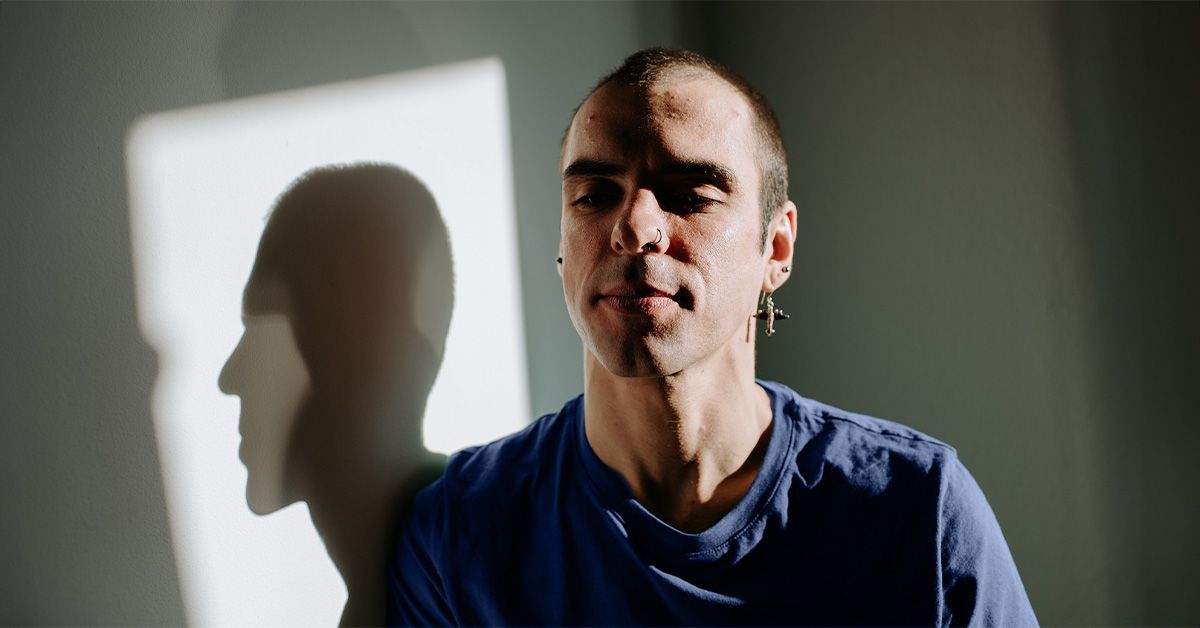This story discusses suicide. If you or someone you know is struggling or in crisis, help is available. Call or text 988 or chat at 988lifeline.org.
A 10-episode miniseries entitled “American Sports Story: Aaron Hernandez” debuts on Sept. 17 on FX. It explores the rise and fall of NFL player Aaron Hernandez — the New England Patriots tight end who was convicted of murder in 2015 and died by suicide in his prison cell two years later.
Hernandez was diagnosed with chronic traumatic encephalopathy, also known as CTE, after his death. The disease can cause impulsive and aggressive behavior, emotional instability and suicidal thoughts, according to Mayo Clinic.
A researcher who studied Hernandez’s brain said at the time that he had the most severe case of the brain disorder that she’d seen in a person his age, raising questions about the root of his violence. Hernandez was 27 when he died. Researchers have not made a direct link between Hernandez’s disease and his behavior.
Here what to know about CTE and Hernandez’s brain.
What is CTE?
CTE is an incurable degenerative brain disorder that causes the death of nerve cells in the brain due to repeated head injuries, according to Mayo Clinic. It doesn’t appear right away and gets worse over time, according to Cleveland Clinic. The condition can lead to behavioral changes, cognitive impairment and progress to other brain disorders, such as dementia.
CTE usually starts in the front of the brain, where most head trauma occurs, and then spreads over time to other regions, Dr. Jesse Mez, co-director of clinical research at Boston University’s Chronic Traumatic Encephalopathy Center, tells TODAY.com.
The effects of CTE may take years to show, as the disease tends to progress slowly, Mez says. However, more repeated head injuries can make it spread faster, as do aging and being more genetically susceptible to CTE.
CTE hasn’t been as thoroughly researched as other degenerative brain diseases, Dr. Daniel Daneshvar, chief of brain injury rehabilitation at Massachusetts General Hospital, tells TODAY.com. In part, that’s because CTE can only be confirmed after death because the brain needs to be examined under a microscope.
As a result, it’s impossible to know how common the condition actually is, Julie Stamm, Ph.D., neuroscientist at the University of Wisconsin-Madison who studies sports-related brain trauma including CTE, tells TODAY.com.
People who develop CTE often have a history of playing sports professionally, according to Cleveland Clinic. Boxers and football players have the highest number of confirmed cases of CTE, but it’s also been found in soccer players, ice hockey players, wrestlers, rugby players and more, research shows.
In addition to athletes, military veterans who have been exposed to explosive blasts and individuals who have experienced repeated physical abuse are also more likely to develop CTE, Daneshvar says.
While many questions about CTE remain, one finding connects all the documented cases: “a prior history of brain injury or repetitive head impacts,” Dr. Willie Stewart, a neuropathologist at Queen Elizabeth University Hospital in Glasgow, Scotland, tells TODAY.com.
How does CTE affect a person’s behavior?
CTE can affect someone’s behavior in a number of ways.
“Memory loss and cognitive changes are the most predictive symptoms of CTE, but other common symptoms include impulsivity, aggression, verbal and physical violence, having a short fuse, loss of control and depression,” Dr. Ann McKee, a neuropathologist and director at Boston University’s Chronic Traumatic Encephalopathy Center, tells TODAY.com.
CTE “has its largest effect on the frontal cortex of the brain, which does play an important role in impulse control and other behaviors,” Mez says.
However, it’s too early in the research to definitively prove that CTE is what causes some individuals with it to display troubling behavior, Mez and Nowinski stress.
What did Aaron Hernandez’s brain scans reveal about his CTE?
McKee, who studied Hernandez’s brain, says she has examined over 700 cases of CTE and found that Hernandez’s brain “was the worst CTE I have seen in a person who died at that age (27).”
Hernandez’s brain was donated by his family to Boston University’s Chronic Traumatic Encephalopathy Center, where it was studied extensively. McKee and her colleagues found that he had stage 3 CTE, with stage 4 being the most severe and usually discovered in people much older.

Research also shows that the longer a person plays tackle football, the greater the risk they will develop CTE. Hernandez played football as a teenager, the New York Times reported.
But it’s still impossible to say if the severity of his CTE caused his violent behavior. “We can’t draw a line between the pathology in someone’s brain and any specific actions someone takes,” Daneshvar says.
Adds McKee: “It’s impossible to know precisely how the CTE impacted him, as many factors likely contributed to his behavior and actions. … CTE likely contributed to his depression and his erratic, impulsive, violent behaviors.”
How did Aaron Hernandez die?
Aaron Hernandez was found dead in his prison cell of an apparent suicide in April 2017. He was serving a life sentence in Massachusetts after being convicted of the murder of Odin Lloyd.
Research shows that people with CTE may be at increased risk of suicide, according to Mayo Clinic.
Read the full article here
















